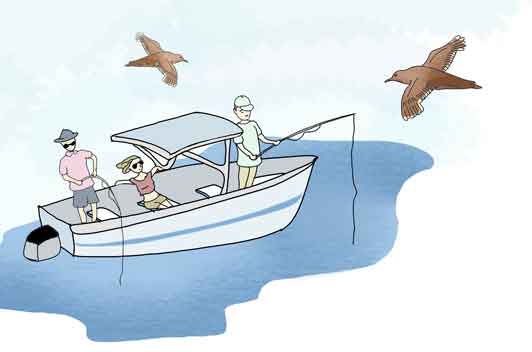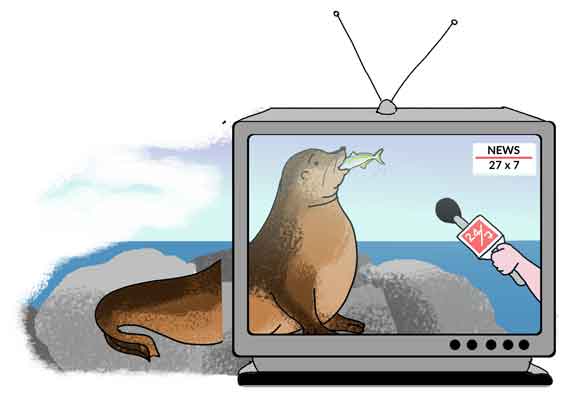The beautiful stretch of Australian coast south of Batemans Bay, New South Wales is a region built on fishing, farming and forestry. In the early to mid-20th century, the area supported two tuna and salmon canneries, a large number of sawmills and a thriving dairy industry. The identity of the region was defined by its fishermen and forestry workers, its working wharves and its rural setting. The region has, however, undergone profound changes over the past few decades.Australia’s first cannery, located in Narooma, closed in the 1970s followed by the Eden cannery in 1999. In Batemans Bay, there remains only one operating sawmill, down from a peak of thirteen and a suite of new national parks have been declared. The dairy industry has also declined in importance and the area has become a popular retirement and holiday location for people from urban centres such as Sydney and Canberra, both of which are about a 2-3 hour drive away. For some of the longer term residents of the south coast, these changes have been traumatic and they have been left feeling bruised and battered by the experience. For the first residents in the area, the Indigenous traditional owners, many of the changes they have seen, have felt profoundly unjust. This is the context in which the Bateman’s Marine Park was declared in 2005.
Marine Parks or Marine Protected Areas (MPAs) are one tool in the vast toolbox of approaches to manage our marine environment. They can be highly beneficial to marine ecological systems by protecting habitat, providing refuge to threatened species and acting as scientific reference areas.Their success in many areas of the world in improving or maintaining marine biodiversity has led to a global campaign to maximise the level of MPA protection in the world oceans, including the development of a range of ‘targets’ specifying minimal MPA coverage. These targets have been actively pursued in Australia for the past decade and we are one of the few jurisdictions in the world that can claim to have achieved the 10% coverage of our oceans that the Convention of Biological Diversity (Aichi biodiversity targets) aspires to. Perhaps unsurprisingly though, the Batemans Marine Park met bitter resistance which continues to this day, and resistance has characterised much of the MPA planning in Australia. In recent years, politicians have succumbed to (or capitalised on) pressure from vocal lobby groups and placed many of the most recent parks under review, or made significant changes to their management. Are we going wrong somewhere? The Batemans Marine Park provides some important insights into this question.
Making sense of complexity – the ‘rules’ of MPA planning
MPAs are incredibly complex tools and their overall success relies heavily on the combined successes of many individual elements of MPA planning and management. MPAs are often established in areas where very little is known about the marine environment, which makes ensuring these successes even more difficult. Biological scientists and policymakers have responded to these gaps in information by developing a range of techniques to make sense of the complex marine ecosystems they seek to manage.
These include quite sophisticated methods of making the best possible guess as to what should be protected and how including modelling programs and detailed seafloor and habitat mapping techniques. In Australia, biologists have attempted to corral the complexity of marine ecological systems by segmenting our oceans and coastlines into broad marine bio-regions which are then used as a framework for MPA planning. The Australian coast is therefore divided into a number of marine bio-regions (https://www. environment.gov.au/node/18075), each of which has unique combinations of geology, oceanography, climatic conditions and assemblages of fauna and flora. These bio-regions are then used as a guide for the placement of MPAs with an overriding aim of ensuring that every bio-region is represented within a network of MPAs and that each of these MPAs incorporates a reasonably sized sample of all the different types of marine ecosystems found within the bio-region. Most Australian MPAs are zoned for different types of use and while no official targets exist, the success of an MPA planning process is often judged by the proportion of the MPA which is ‘no-take’. In the case of the Batemans Marine Park, there seemed to be a common understanding amongst stakeholders that the Conservation sector and the Government were aiming for approximately 20% of the park to be included in no-take (sanctuary) zones (the final no-take zoning level achieved was around 19%). This figure is based on advice from marine scientists about optimal levels of protection for achieving desired biodiversity benefits.
These (often unwritten) ‘rules’ of MPA planning have been applied in Australia for many years. They are extremely effective means of managing biological systems in the absence of detailed knowledge. The problem arises when this biological system of planning is applied to the incredibly dynamic, diverse and complex social systems that exist within the human environment.
Biological planning in a human world

The Batemans Marine Park was implemented using the same process applied in other NSW marine parks and commonly employed across the country. In the same way that biologists break down the biophysical world into manageable components based largely on habitat type, planners have tended to segment the community into stakeholder groups along the lines of the use type. This fits nicely with the biological approach to planning because it allows planners to directly assign specific ecological threats to a distinct group of people, and therefore managing the threat becomes a simple matter of managing those people. Unfortunately, this approach is problematic because it tends to assume these groups are distinct, homogenous collections of people with similar values, beliefs, ideas and practices. In fact, there can be as much diversity within user groups as there is across them. In addition, focusing on use type alone, and labelling some as being a ‘threat’ can lead to value judgements about some users as well as the use, thereby creating ‘good guys’ and ‘bad guys’ within a debate, and polarising the community and mobilising lobby groups. This was certainly the case in the Batemans Marine Park where the animosity between fishers and the conservation sector became so intense that property was damaged, threats were made against individuals, a conservation group was ‘infiltrated’ and an attempted takeover staged and the local newspapers were flooded with enraged, often vicious letters from both sides.
Segmentation based on the use-type alone also greatly disadvantages smaller, disenfranchised, vulnerable or marginalised user groups. Smaller, or less organised user groups, are less likely to have the political or social capital to defend themselves against a system that assumes that any users involved in extractive use are a threat, and any that are not are benign. The Batemans Marine Park is seen as a huge success amongst conservation groups and some recreational fishers, while at the same time it is viewed as a disaster for Indigenous cultural fishers and small scale commercial fishers. The debate over MPA management in this park was clearly dominated by the conservation sector and recreational fishers and both groups walked away with big wins at the expense of these smaller groups. Do the benefits as perceived by some in the community outweigh the negatives for others? Who should have the power to make this determination? And what wider impacts are felt within the community when these small, yet important sectors take the brunt of the impacts? The Batemans Marine Park example raised concerns about wider social costs including the ability to access local seafood, depression, marriage breakdowns, suicide and declines in mental and physical health amongst sections of the commercial fishing and Indigenous communities.

An alternative approach to sector-based planning is to think about segmentation that also includes consideration of values, beliefs and attitudes rather than use type alone. Preliminary work in this area highlights a surprising number of shared values across use types and has provided some key insights into where differences occur that do not always neatly correlate with use types. More importantly, however, it points to clear commonalities that can be used as the basis of consensus building and empathy. An understanding of the different value systems that operate within the community can help to break down misunderstandings and stereotypes across different sectors, ensure representation of a greater diversity of voices in MPA negotiations and begin to challenge the value judgements of sectoral interest groups based solely on their type of use.
Is knowledge the exclusive domain of science?
Some of the most significant objections to the Batemans Marine Park were rooted in the way it elevated scientific knowledge as the superior or primary knowledge source. Locally based traditional and cultural-ecological knowledge were regarded as secondary or lower-order sources and were turned to only when there were gaps in the scientific knowledge or insufficient resources to adequately apply a science-based approach to knowledge generation. This was personally offensive to many of the stakeholders I interviewed in this area who considered themselves authoritative voices in relation to their local marine environment and fisheries. Local Ecological Knowledge (LEK) and Traditional Ecological Knowledge (TEK) are a more ‘messy’ form of knowledge generation and application in that they involve the vagaries of human memory, the willingness of the knowledge holders to share information and, of course, the anathema to scientists – ‘subjectivity’. Yet embracing this complexity can have many benefits not just in providing highly localised, fine-scale data on environmental conditions and environmental change over time, but it can also build relationships of mutual respect, enable community members to feel engaged and valued in the process of MPA planning and build a sense of community ownership in the management systems that are developed. It can also facilitate direct engagement of community members in making the trade-off decisions that are an inevitable feature of MPA planning.
It’s all the media/politicians fault
My interviews with stakeholders in the Batemans Marine Park uncovered a tendency to blame the political process and/or the media for many of the problems associated with its planning. Unfortunately, MPA planning is inherently a political process. As much as we may wish for politics to be left out of MPA planning, it is unrealistic to expect it ever will. Instead, we need to think carefully about how we can work within the political system to ensure equitable and effective management responses. The political will to establish an MPA is an extremely influential determinant of whether an MPA goes ahead, in what form and whether it is successful in the long term. This political will is extremely susceptible to the influence of well organised, vocal lobby groups and, of course, the media. As was seen in the Batemans Marine Park, the media can exacerbate existing tensions by its preference for stories that focus on conflict and drama. Media coverage is often simplistic, sensationalist and thrives on controversy and conflict. Lobby groups are increasingly using social media to influence politicians, calling on members of the public to ‘save’ sections of the ocean from fishing or from ‘lock out’ by the click of a button.
Embracing the complexity of politics and its uneasy bedfellow, the media, involves allowing democratic processes into MPA planning rather than attempting to circumvent it. This involves embracing the incorporation of ‘bottom up’ participative planning right from the outset. This is particularly important in the earliest stage of MPA planning – the setting of the MPA objectives.

Again, the Batemans Marine Park provides an important lesson. A marine park in this area was always going to be very, very hard. The area was already struggling on the back of so much social change and had a heightened sensitivity to any outside interventions that might impact its declining primary production capabilities. Despite these sensitivities, the Government of the day supported by the conservation sector, pushed ahead with its plan using the same techniques and ‘rules’ that it had applied elsewhere in quite different settings. There was little or no explanation as to why the marine park was considered necessary, other than that it formed part of the Government’s commitments under the Convention of Biological Diversity. One of the inherent dangers of focusing on MPAs as an end rather than a means is that the community is left baffled as to what the MPA was meant to achieve. In the Batemans example, the park was planned and is now managed to maximise biodiversity conservation but all the public messages were about improvements in fishing opportunities. So the entire process degenerated into a debate about whether no take zones do result in improvements to fishing, with lobby groups, scientists and politicians lining up on both sides. Locals provided alternative suggestions on how to improve fishing opportunities which were largely ignored (because the park was never intended as a fisheries management tool) further undermining an already fraught relationship between Government and the community.
Different groups within the community will have different ideas of the values they wish to see protected in their area and how that should be achieved. The community should therefore get a say in what they feel the objectives of marine and coastal management practices should be and whether an MPA is the best tool to achieve that. Involving the community in setting local objectives means that the planning process begins with a common understanding of what it is trying to achieve. Once some level of consensus is reached on MPA objectives, they can provide a framework to guide the trade off decisions.
Embracing complexity
We can not rely on MPAs alone as a technical fix for the incredibly complex problem of marine conservation management. However, if carefully implemented and managed, they can be an important tool. It is folly, however, to believe that MPAs can be implemented using formulaic planning processes that follow a roadmap designed by scientists and policymakers alone. Targets for global MPA coverage of our oceans and formulas on how much of an MPA should be no-take may make the process of planning a little easier from a purely scientific point of view but, in reality, the complexity of the human environment suggests we are setting ourselves up for failure if we adhere to these numbers too tightly. Instead, we need to acknowledge there is no ‘one size fits all’ approach to MPA planning and management and that, in some cases, an MPA may not even be the most appropriate response, at least in the short term. Instead, we can look to the complexity within the human environment to teach us lessons on how we can do things better, in a way that celebrates the diversity of the human condition just as we celebrate the diversity of marine life.






